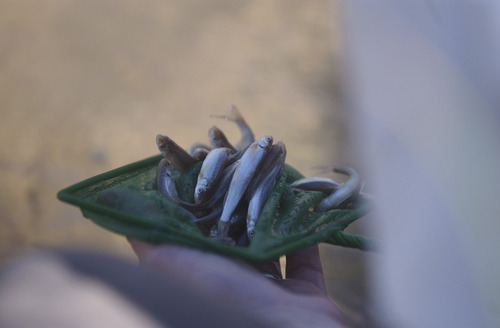This is an archived article that was published on sltrib.com in 2011, and information in the article may be outdated. It is provided only for personal research purposes and may not be reprinted.
A river may not run through the new offices of the Washington County Water Conservancy District, but one will run next to it after construction of an artificial stream is completed, raising concerns of some activists in the area.
"We think that the money should be spent on recovery efforts of [endangered fish] species in the Virgin River," said Jim McMahon, a board member of Citizens for Dixie's Future, which has been critical of the conservancy district policies, including its efforts to build a pipeline from Lake Powell to St. George.
He said the money should go toward increasing water in the river by buying existing water rights instead of building the artificial river to be named the Red Hills Desert Garden and used as an educational tool by the conservancy district.
"Why not purchase instream flow [to the Virgin] and actually save fish and be done with it," said McMahon.
The controversy surrounds the woundfin minnow and Virgin River chub, both listed as endangered species, and the Virgin spinedace that is considered a sensitive species by the state. The only place the woundfin is known to exist is in the Virgin River downstream from Pah Tempe Hot Springs outside of La Verkin in Washington County.
The reintroduction program created in 2003 includes regular transplants of the fish so rare that no evidence of the woundfin existed in 2005. The fish for the program are raised from Utah brood stock at federal hatcheries, including the Dexter National Fish Hatchery and Technology Center in Dexter, N.M. Overseen by the U.S. Fish and Wildlife Service, the program is implemented by the Division of Wildlife Resources, which releases the fish shipped from hatcheries in special trucks.
Barbara Hjelle, assistant director with the water conservancy and its attorney, said the artificial river being built includes a riparian area to emulate the ecosystem along the Virgin River, as well as plant species from the Colorado Plateau, Great Basin and Mojave Desert that all come together at St. George.
The city will supply recirculating water for the artificial stream.
Proponents say the project has been in the planning stage for two years and will allow the public a chance to learn about the rare fish and observe them in a glassed viewing area. It is also intended to teach effective water conservation methods and water-wise landscaping practices
"Why is it that during these tight times that the water district has money for a fake river and fish viewing area when the real river is still seriously degraded?" asked Christi Nuffer, administrative director of Citizens for Dixie's Future. "We thought times were tough and cash was short, but the district continues its pattern of wasteful spending. If you wonder where the cash is coming from take a look at your recently distributed property tax bill. Note the line item for the water district. Are you willing to pay for a fake river on the hill when we have a real river in desperate need of these funds running through our neighborhoods?"
Citizens for Dixie's Future estimates $1.2 million is being spent on the project — money that members believe should go to the recovery program to restore the rare fish populations.
The conservancy district is funded through taxes, water sales and impact fees.
Hjelle said that so far the cost for the Desert Garden is $35,000 for stream design, $65,000 for water delivery and the future education center and $318,000 for construction of the stream.
It will be installed next to the conservancy's office at 533 E. Waterworks Drive off the Red Hills Parkway in St. George.
"The garden will [also] showcase desert plant species," said Hjelle. "We are seeking grants for additional funding. Future costs will depend upon bids and other factors. We hope to complete the garden next year."
The Department of Natural Resources has contributed $480,000 to the project.
Reed Harris, Virgin River project director for the DNR, thinks the Red Hills Desert Garden is a good idea.
"We want to show the resources we have in the river," said Harris. "Many people have never seen a sensitive species; the [garden] is one way to raise consciousness that we have listed species."
Responding to criticism that money should go to water rights for the Virgin River and fish recovery, rather than the garden, Harris said the Virgin's water flow is already sufficient to sustain fish. "Now we have seen more [fish] than years past," he said.
Harris said that in 40 years of working with listed species, he has learned the most effective method is through cooperation with various agencies, especially when so much pressure is put on the Virgin River from humans and wildlife.
"It's important that agencies work with flexibility," he said. "A lot of people want a wild Virgin stream, but with [more than] 100,000 people, there are a lot of uses."
Endangered woundfin minnow
Woundfin
Scientific name • Plagopterus argentissimus
Size • 2 to 3 inches long
Life span • Two to three years
Location • Lives only in a section of the Virgin River in Washington County
Diet • Anything from insects to floating organic matter
Listing • Endangered
Numbers • Estimated at 10,000
Virgin River chub
Scientific name • Gila seminuda
Size • 8 to 10 inches
Life span • More than 10 years
Location • Lower Virgin River in Washington County to Lake Mead, Nev.
Diet • Small fish, insects and plant matter
Listing • Endangered
Numbers • Estimated about 10,000
Virgin spinedace
Scientific name • Lepidomeda mollispinis
Size • 5 inches
Life span • Up to 10 years
Location • Virgin River and its tributaries
Diet • Insects
Listing • Under protection of conservation agreement
Numbers • Undetermined
Sources: Virgin River Program, DWR







